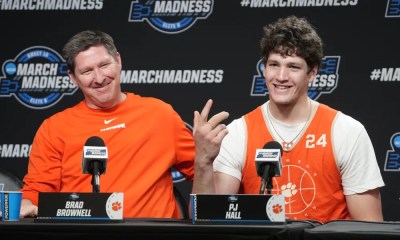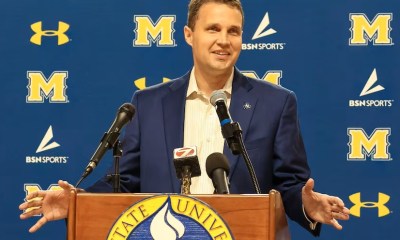
During every off-season, I often find myself pondering the rationale behind schools’ preference for hiring assistants devoid of head coaching experience with one caveat. If the assistant is already part of a successful program that is rolling, such a move makes sense, as they can seamlessly carry on the existing framework, maintain player relationships, and contribute to the program’s continued success. Numerous instances validate the effectiveness of this approach.
However, the perplexity arises when schools opt to hire assistants for their initial head coaching roles without prior experience in such a position in a new place where they have to create the framework for success and usually are rebuilding. Typically, there’s an on-the-job learning curve regardless, and many of these assistants struggle to navigate it successfully, often leading to their downfall.
Even more confounding are the cases of coaches who have never ventured beyond the confines of perennial powerhouses like Duke, Kansas, or UNC. It becomes a recurring pattern – a former player who served as an assistant at Duke or UNC, under the tutelage of iconic coaches like Coach K or Roy, secures their first assistant coaching position at the same alma mater and never ventures beyond until they get their first head job. When faced with the challenge of a mid-major or a mid level P5 program, they often encounter difficulties.
From an AD’s perspective, it seems imperative to seek candidates who have, at the very least, gained experience at a mid-major or a similar setting before assuming a head coaching role. Former players starting their coaching careers on the benches of Duke or UNC, under legend coaches, where recruiting largely takes care of itself, may find the transition challenging if they’ve never been exposed to a different environment. Examples like Jerod Haase, C. B. McGrath, and Steve Wojciechowski underscore this point.
The prevalence of a silver-spooned, good ole boy network in college basketball cannot be overlooked. Connections and playing pedigrees often play a significant role in opening doors. Personally, they should lean towards individuals who have diligently climbed the coaching ladder from the bottom levels on coaching talent, demonstrating coaching acumen and some substantiated head coaching experience elsewhere are always a bonus in our opinion. High school, JUCO, D2 etc it seems to help with the learning curve and give coaches a good base.
Most of the top 10 conferences teams should be able to find successful coaches from the bottom 10-32 conferences with head coaching experience. Anyone in the bottom 10 to 32 type mid and low major jobs should likely focus on these lower level coaches more than they even do to find their coaching talent more so than the first time head coach who was an assistant up the ladder. If you have demonstrated you can coach, you can probably coach at that level.
Historically
Here are examples of highly successful NCAA coaches who began their careers as head coaches at lower levels.
| Jim Calhoun | High School | ? |
| Lute Olson | JUCO | 103-22 |
| Eddie Sutton | JUCO | 84–14 (.857) |
| Bob Huggins | NAIA | 71–26 (.732) |
| John Beilein | JUCO/D2/D3 | 75–43 (.636) /163–94 (.634) /20–6 (.769) |
| Bo Ryan | D3 | 353–76 (.823) |
| John Chaney | D2 | 225–59 (.792) |
| Jerry Tarkanian | JUCO | ? |
| Cliff Ellis | NAIA | 78–12 (.867) |
| Jim Larrañaga | D2 | 27–26 (.509) |
| Tom Penders | D2 | 54–18 |
| Homer Drew | NAIA | 252–110 |
| Bob McKillop | High School | 182–51 |
I included Calhoun and McKillop because they were hired for their first D1 positions directly from being high school head coaches. Even high school head coaching appears to be beneficial. Take someone like Larranaga, who may not have achieved significant success, but likely gained insights from the experience.
Historically, there have been some failures, with Kim Anderson being the most notable example after winning a D2 title and facing significant challenges at Missouri. However, this seems more like an exception than a rule. Even coaches historically who had lower level head coaching experience, but who didn’t achieve remarkable success, such as Ben Braun, Larry Hunter or Eddie Payne, managed to sustain long head coaching careers and continued to receive opportunities, likely based on achievements in part outside of D1.
Current D1 Coaches That Were at Lower Levels
Reviewing the current list of coaches, it was somewhat surprising to note how many had previously served as head coaches at lower levels before transitioning to D1. However, the number is still not comparable to the frequency of hiring first-time head coaches directly from assistant positions.
| Kelvin Sampson | NAIA | 73–45 (.619) |
| Bruce Pearl | D2 | 231–46 (.834) |
| Chris Beard | JUCO/D2 | 64-28/ 47–15 (.758) |
| Grant McCasland | JUCO/D2 | 142–32 (.816), 55–12 (.821) |
| Dana Altman | JUCO | 123-24 |
| Greg McDermott | D2 | 116–53 (.686) |
| Steve Alford | D3 | 78–29 (.729) |
| Brad Underwood | JUCO | 132–85 (.608) |
| Chris Jans | JUCO | 159–45 (.779) |
| Mike Rhoades | D3 | 197–76 (.722) |
| Leon Rice | JUCO | 1 year |
| Steve Forbes | JUCO | 130–34 (.793) |
| Josh Schertz | D2 | 337–69 (.830) |
| Jerrod Calhoun | D2 | 124–38 (.765) |
| Tobin Anderson | D2/D3 | 209-62 |
| Bob Marlin | JUCO | 123–35 (.778) |
| Ryan Odom | D2 | 21–10 (.677) |
| Craig Smith | NAIA | 72–29 (.713) |
| Kevin Keatts | Prep | 262–17 |
| Marvin Menzies | JUCO | 24–8 (.750) |
| A. W. Hamilton | Prep | 237-22 |
| Dave Paulsen | D3 | 262-120 |
| Ross Hodge | JUCO | 146–24 (.859) |
| Pat Skerry | D2 | 24–25 (.490) |
| Travis Ford | D2/NAIA | 67–31 (.684) |
| Keith Dambrot | D2 | 88-36 |
| Tim Miles | D2 | 78–39 (.667) |
| Rick Croy | JUCO | 130–35 (.788) |
| Todd Simon | Prep | 192-9 |
| Paul Sather | D2/NAIA | 188–89 (.679) /94–62 (.603) |
| Kyle Keller | JUCO | ? |
| Steve Smiley | JUCO | 152–45 (.772) |
| Jay Ladner | JUCO | 45–13 (.776) |
| Chris Crutchfield | JUCO | 35–29 (.547) |
| Ed Conroy | D2 | ? |
| David Ragland | JUCO | 44–19 (.698) |
Scott Nagy Scott Davenport , Ron Hunter and a few others took the Rick Byrd route and brought their D2’s to D1.
I would argue that the overall success rate among coaches with prior experience at lower levels, particularly those from JUCO, appears to be higher than the percentage of assistants securing their first head coaching job in D1. JUCO coaches, in particular, demonstrate a strong translation of skills. A highly successful JUCO coach is typically recruiting D1-caliber talent from high school that didn’t have the grades or like their options. In today’s landscape, they are also actively involved in the transfer portal, securing D1-level talent as well. Similarly, top D2 coaches are likely uncovering hidden gems with D1 potential and also dabble in the portal some. Notably, high-caliber fifth-year prep coaches like Kevin Keats or Todd Simon were adept at recruiting and coaching 5-star talents and NBA players, having successfully navigated the process of bringing them to their respective prep schools.
Kim Anderson
The coach who may deter some athletic directors, especially from major conferences from adopting this approach is Kim Anderson. On paper, his hiring seemed promising at the time. Anderson, a Missouri alum with NBA experience, had served as an assistant coach at both Missouri (twice) and Baylor. His familiarity with Missouri both the state and university was apparent. Having led Central Missouri State from 2002 to 2014, achieving an impressive record of 274-94, including three final fours and a D2 national title in his concluding season.
Despite his successful background, Anderson’s tenure in the SEC didn’t pan out as expected, resulting in a disappointing record of 27-68 overall and 8-46 in three seasons. In contrast to other coaches who made a smoother transition from lower levels to mid-major programs, Anderson’s leap might have been one of the most significant going from D2 to the SEC. Even notable figures like Bo Ryan spent a couple of years at Milwaukee in the Horizon before moving up. Although Anderson demonstrated strong recruiting skills in his initial season, securing two top 55 consensus prospects, the overall outcome didn’t reflect the initial promise on paper.
While I wouldn’t discount the idea of hiring a D2 coach for a Power conference position, especially an alum who had coached at that school this hire clearly did not work out. Major conferences shouldn’t have to hire from D2. They should be able to draw successful mid major coaches. Anderson would take another job in D2 after Mizz, and limp to a .500 record there so perhaps something had happened in that period and he wasn’t the same coach. It’s just strange to fail this badly after having won like he had.
Anomaly
One anomaly we found in our research certainly was one of the most accomplished mid major coaches John Becker. He struggled as badly as you will see in D3 in his early 30’s but this could have just been a terrible situation.
| John Becker | D3 | 6–44 (.120) |
Pro
Being a lower level pro coach, or even NBA head coach doesn’t insure success. Ask Isaiah Thomas or Sydney Lowe. It also seems helpful to have some head coaching experiences even if it’s international professionally or in the Gleague or CBA. Here are some current head coaches that had been a head coach professionally.
Conclusion
Consistent excellence across various high-level roles tends to yield favorable outcomes, as it diminishes the reliance on chance occurrences and obviates the need for on-the-job training. The ability to coach effectively becomes particularly evident in such scenarios. Demonstrating proficiency in multiple diverse situations or roles further diminishes the influence of fortuitous circumstances or advantageous positions, whether over an extended period or in varying contexts. As an athletic director of a school outside the top 10 conferences, this approach would undoubtedly be my focus, on proven head coaching experiences at these lower levels rather than scouting on the benches of renowned institutions like UNC, Michigan State, Duke, or other Power 5 conferences who in some cases had never been at a place like a mid major.
Related

Combat Sports
Tyson vs Paul: Experience and Exposure Clash

College Basketball
Top 300 Transfer Portal Basketball Rankings 2024

College Basketball
Top 300 Transfer Portal Basketball Rankings 2024

College Basketball
2024 Top 100 JUCO Basketball Recruiting Player Rankings

College Basketball
Looking Ahead: Way Way Too Early 2024-25 Rankings

College Basketball
Ranking Redux: Re-Ranking The 2023 Transfer Portal

College Basketball
Freshmen vs Portal Rankings: A Comprehensive Study

College Basketball
Summer Clearance: Bargain Bin Shopping in the Portal

More Featured
28.8%…The Michael Jordan 3 Point Debate

College Basketball
The Top 300 Returning Players














